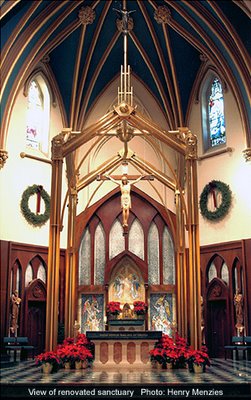Sometimes, the old ways just worked better. Not so obviously at first. But sooner or later, the benefits of the old ways come out in unexpected ways. Just like the benefits of virtue.
Lately, there's been a good deal of attention paid to the potential of a bird flu epidemic. This has even stimulated
some discussion about modifying certain modern practices in the distribution of the Eucharist if an epidemic really get going, to prevent the spread of contagion.
Let's review how Communion is often done today. The priest consecrates the bread and wine. The bread is handed to the communicant, who puts the bread into his own mouth with his hand, then also drinks from a common cup or chalice, whose rim is wiped with a cloth after each person drinks.
Contrast this with the bad old days we're taught to despise by many bishops and diocesan personnel. The priest would consecrate the bread and wine, but would bring only the bread to the communicants; he would then place the Host on the tongue of each person. No wine would be offered at all.
Add to these differences that before Vatican II, there was no such thing as shaking hands at the Peace, before Communion.
So let's look at all these changes from the standpoint of preventing the spread of disease -- many diseases, not just bird flu.
Under the new customs, everyone shakes hands with several other people a few minutes before Communion. News flash: shaking hands is a nifty way to transfer germs from one person to another. Then people go up for Communion, take their consecrated bread in their own now-contaminated hands, and put it in their mouth. Next, they drink a sip of wine from the same cup as several hundred other people, the rim of which has been ineffectually wiped with a cloth which itself is just collecting germs as it goes along.
Under the old customs, only one person ever touched the Host before it arrived directly on your tongue: the priest. The priest who publicly washed his hands at the beginning of the Offertory. I know, it was a ceremonial washing. I served Mass back then, and knew that some priests wanted only a few drops on the their fingertips, while others wanted a veritable flood. But either way, I never saw a priest approach either the side of the altar to wash his hands, or the altar rail to distribute Communion, with anything but scrupulously clean hands.
I hope it's pretty clear to everyone, whether liberal or conservative, that the old customs were simply less likely to transmit sickness among the congregation.
But we added the germ-spreading handshakes, and the taking of the Eucharist in the germy hand, and the drinking from the germy common cup, so we could be -- I don't know what. Trendier. Up with the times. Just different from the past. More like the Protestants.
What we got was sicker. In more ways than one.


